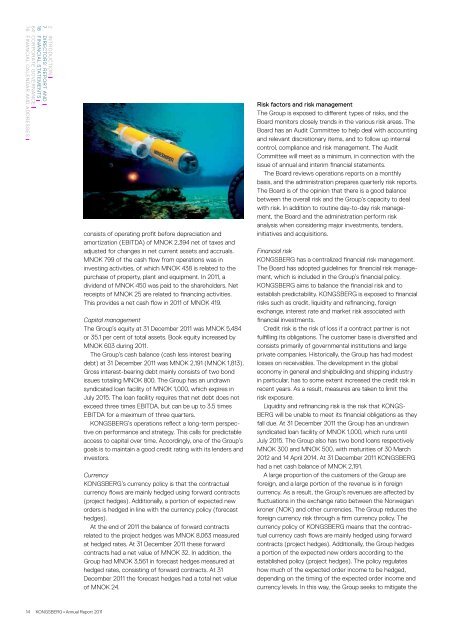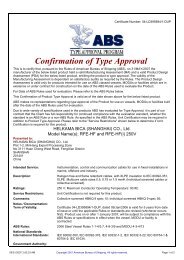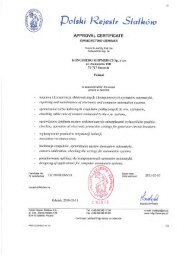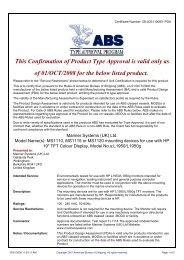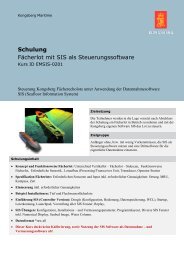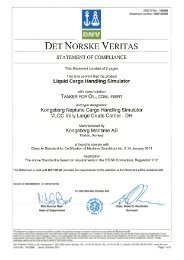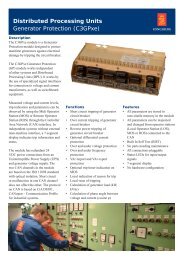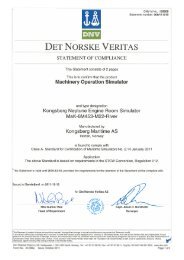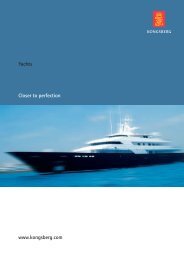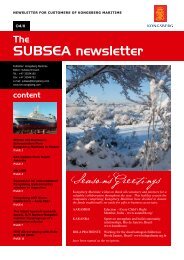Annual Report 2011 - Kongsberg Maritime - Kongsberg Gruppen
Annual Report 2011 - Kongsberg Maritime - Kongsberg Gruppen
Annual Report 2011 - Kongsberg Maritime - Kongsberg Gruppen
You also want an ePaper? Increase the reach of your titles
YUMPU automatically turns print PDFs into web optimized ePapers that Google loves.
2 INTRODUCTION<br />
7 DIRECTORS’ REPORT AND<br />
18 FINANCIAL STATEMENTS<br />
64 CORPORATE GOVERNANCE<br />
76 FINANCIAL CALENDAR AND ADDRESSES<br />
14<br />
KONGSBERG <strong>Annual</strong> <strong>Report</strong> <strong>2011</strong><br />
consists of operating profit before depreciation and<br />
amortization (EBITDA) of MNOK 2,394 net of taxes and<br />
adjusted for changes in net current assets and accruals.<br />
MNOK 799 of the cash flow from operations was in<br />
investing activities, of which MNOK 438 is related to the<br />
purchase of property, plant and equipment. In <strong>2011</strong>, a<br />
dividend of MNOK 450 was paid to the shareholders. Net<br />
receipts of MNOK 25 are related to financing activities.<br />
This provides a net cash flow in <strong>2011</strong> of MNOK 419.<br />
Capital management<br />
The Group’s equity at 31 December <strong>2011</strong> was MNOK 5,484<br />
or 35.1 per cent of total assets. Book equity increased by<br />
MNOK 603 during <strong>2011</strong>.<br />
The Group’s cash balance (cash less interest bearing<br />
debt) at 31 December <strong>2011</strong> was MNOK 2,191 (MNOK 1,813).<br />
Gross interest-bearing debt mainly consists of two bond<br />
issues totaling MNOK 800. The Group has an undrawn<br />
syndicated loan facility of MNOK 1,000, which expires in<br />
July 2015. The loan facility requires that net debt does not<br />
exceed three times EBITDA, but can be up to 3.5 times<br />
EBITDA for a maximum of three quarters.<br />
KONGSBERG’s operations reflect a long-term perspective<br />
on performance and strategy. This calls for predictable<br />
access to capital over time. Accordingly, one of the Group’s<br />
goals is to maintain a good credit rating with its lenders and<br />
investors.<br />
Currency<br />
KONGSBERG’s currency policy is that the contractual<br />
currency flows are mainly hedged using forward contracts<br />
(project hedges). Additionally, a portion of expected new<br />
orders is hedged in line with the currency policy (forecast<br />
hedges).<br />
At the end of <strong>2011</strong> the balance of forward contracts<br />
related to the project hedges was MNOK 8,063 measured<br />
at hedged rates. At 31 December <strong>2011</strong> these forward<br />
contracts had a net value of MNOK 32. In addition, the<br />
Group had MNOK 3,561 in forecast hedges measured at<br />
hedged rates, consisting of forward contracts. At 31<br />
December <strong>2011</strong> the forecast hedges had a total net value<br />
of MNOK 24.<br />
Risk factors and risk management<br />
The Group is exposed to different types of risks, and the<br />
Board monitors closely trends in the various risk areas. The<br />
Board has an Audit Committee to help deal with accounting<br />
and relevant discretionary items, and to follow up internal<br />
control, compliance and risk management. The Audit<br />
Committee will meet as a minimum, in connection with the<br />
issue of annual and interim financial statements.<br />
The Board reviews operations reports on a monthly<br />
basis, and the administration prepares quarterly risk reports.<br />
The Board is of the opinion that there is a good balance<br />
between the overall risk and the Group’s capacity to deal<br />
with risk. In addition to routine day-to-day risk management,<br />
the Board and the administration perform risk<br />
analysis when considering major investments, tenders,<br />
initiatives and acquisitions.<br />
Financial risk<br />
KONGSBERG has a centralized financial risk management.<br />
The Board has adopted guidelines for financial risk management,<br />
which is included in the Group’s financial policy.<br />
KONGSBERG aims to balance the financial risk and to<br />
establish predictability. KONGSBERG is exposed to financial<br />
risks such as credit, liquidity and refinancing, foreign<br />
exchange, interest rate and market risk associated with<br />
financial investments.<br />
Credit risk is the risk of loss if a contract partner is not<br />
fulfilling its obligations. The customer base is diversified and<br />
consists primarily of governmental institutions and large<br />
private companies. Historically, the Group has had modest<br />
losses on receivables. The development in the global<br />
economy in general and shipbuilding and shipping industry<br />
in particular, has to some extent increased the credit risk in<br />
recent years. As a result, measures are taken to limit the<br />
risk exposure.<br />
Liquidity and refinancing risk is the risk that KONGS-<br />
BERG will be unable to meet its financial obligations as they<br />
fall due. At 31 December <strong>2011</strong> the Group has an undrawn<br />
syndicated loan facility of MNOK 1,000, which runs until<br />
July 2015. The Group also has two bond loans respectively<br />
MNOK 300 and MNOK 500, with maturities of 30 March<br />
2012 and 14 April 2014. At 31 December <strong>2011</strong> KONGSBERG<br />
had a net cash balance of MNOK 2,191.<br />
A large proportion of the customers of the Group are<br />
foreign, and a large portion of the revenue is in foreign<br />
currency. As a result, the Group’s revenues are affected by<br />
fluctuations in the exchange ratio between the Norwegian<br />
kroner (NOK) and other currencies. The Group reduces the<br />
foreign currency risk through a firm currency policy. The<br />
currency policy of KONGSBERG means that the contractual<br />
currency cash flows are mainly hedged using forward<br />
contracts (project hedges). Additionally, the Group hedges<br />
a portion of the expected new orders according to the<br />
established policy (project hedges). The policy regulates<br />
how much of the expected order income to be hedged,<br />
depending on the timing of the expected order income and<br />
currency levels. In this way, the Group seeks to mitigate the


